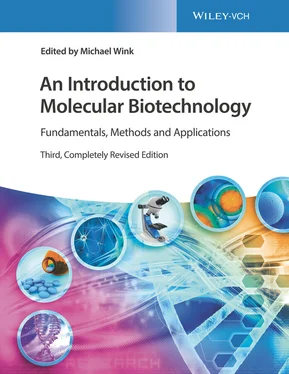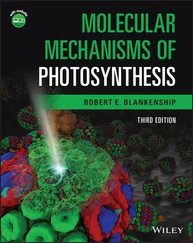3.2 Structure of Bacteria
Compared with eukaryotic cells, bacteriahave a fairly simple structure ( Figure 1.2a). The outside of Gram‐positive bacteriais shielded by a thick peptidoglycan cell wall, known as the murein sacculus. In Gram‐negative bacteriaa larger periplasmic space, where some of the metabolic processes take place, lies between a thin cell wall and the cytoplasmic membrane ( Figure 3.27). To the outside, they have an outer membrane containing lipopolysaccharide(LPS) and porinchannels. The cytoplasmic membrane contains many membrane proteins, including transporters, ABC transporters, receptors, and enzymes. There is no compartmentalization in bacterial cells (i.e. they do not contain organelles). However, the cytoplasmic membrane is sometimes in‐folded, which makes it resemble a eukaryotic endomembrane system. On the surface, many bacteria carry flagella and pili, which enable bacteria to move and adhere to surfaces.
Contrary to earlier views, bacteria also contain various types of cytoskeletal structures, either based on FtsZ, Mreb/Mbl, or EF‐Tu proteins. FtsZ seems to be related to tubulin and Mreb/Mbl to actin, as found in eukaryotes. There seems to be no eukaryotic equivalent to EF‐Tu. All three forms may coexist in the same cell. Underneath their cytoplasmic membrane, bacteria have a cytoskeleton consisting of monomer proteins. Monomer EF‐Tu proteins, for example, can form protofilaments. There are also cytoskeleton‐like interconnections or fibers.
The proteins are synthesized in ribosomesthat lie freely in the cytoplasm or are associated with the inside of the cytoplasmic membrane ( Figure 1.2a).
Bacteria carry their genetic information on one single chromosome. This ring‐shaped DNA strand is also known as a nucleoid. There are additional ring‐shaped molecules called plasmids, which also carry genetic information and may include antibiotic resistance genes. Modified plasmids play an important role as cloning vectors in molecular biology and biotechnology (see Chapter 15).
Bacteria continue to be the favorite “pets” of molecular biologists and biotechnologists. Basic research on genetics, molecular biology, and biochemistry is often first carried out in bacteria such as E. coli . Some bacteria are even indispensable for the cloning and expression of DNA (see Chapters 15and 16).
Infectious diseasesare probably as old as mankind. They can be caused by bacteria, fungi, viruses, protozoa ( Plasmodium causing malaria, Trypanosoma causing sleeping sickness), and a variety of intestinal worms. These organisms are collectively called pathogens. Only a small fraction of microbes ( Chapter 6) play a role as pathogens. Bacterial infectionsare the cause of many diseasesin humans, animals, and plants. Bacterial pathogens often carry specialized virulence genes, which can be passed on to other bacteria via horizontal gene transfer. Some bacteria damage the host through sophisticated toxins that interfere with signaling pathways. Tetanus toxinsfrom Clostridium tetani act as proteases. In the synapses, they specifically hydrolyze SNARE proteins, thus blocking neuronal signal transduction. Cholera‐causing Vibrio choleraeproduces cholera toxin, an enzyme that redirects the transfer of ADP‐ribose from NAD +to the α‐subunit G sof a G‐protein. This inhibits GTPase, and the once activated adenylyl cyclases remain permanently active, producing cAMP. As a consequence, intestinal cells secrete excessive amounts of Cl +ions and water, resulting in diarrhea. Bordetella pertussis, the cause of whooping cough, produces enzymes that activate the α‐subunit G iof the G‐protein, preventing G ifrom regulating its target proteins. This also leads to an overproduction of cAMP. Anthrax( Bacillus anthracis) is an acute infectious disease of sheep and cattle but can also kill humans. The anthrax bacteria secrete two toxins; they differ in the composition of the A subunit, whereas their B subunits are identical. The B subunit binds to cell surface receptors, mediating the uptake of the A subunits (differentiated into lethal factor and edema factor) into the cell. The edema factoris an adenylyl cyclase that overproduces cAMP leading to edema in skin and lung. The lethal factor is a protease that degrades several activated members of the mitogen‐activated protein (MAP) kinase kinase, leading to a disruption of signal pathways and finally death.
The discovery and the development of new antibiotics from various Streptomyces and fungal species in the second half of the twentieth century was a milestone in medical history, saving millions of lives. Antibiotics were given as single compounds not only to millions of people but also to animals. This favored the development of resistance through target site modification (transporter, cell wall, ribosomal proteins, rRNA), enzymes that degrade antibiotics (β‐lactamase), enzymes that inactivate antibiotics, and ABC transporter (efflux pumps). Important resistance types are extended‐spectrum β‐lactamase ( ESBL), New Delhi metallo‐β‐lactamase 1 ( NDM‐1), AmpC(β‐lactamases), Klebsiella pneumoniae carbapenemase ( KPC), vancomycin‐resistant enterococci ( VRE) , vancomycin‐resistant Staphylococcus aureus ( VRSA), pristinamycin‐resistant S . aureus ( PRSA), and methicillin‐resistant S . aureus ( MRSA).
In the meantime, several pathogenic bacteria(e.g. Pseudomonas aeruginosa and S. aureus ) have become increasingly resistant to effective antibiotics, causing thousands of death. This is why the development and production of new antibiotics should remain a high priority for the biotechnological industry. Also the development, of reliable and fast analytical devices, is a relevant area of biotechnology.
Organic low‐molecular‐weight compounds such as amino acids or recombinant proteins are often produced in bacteria (see Chapter 16). Sometimes, genetic manipulation of biosynthetic pathways can give a substantial boost to the yield ( Chapter 31).
The human body harbors trillions (around 10 14cells) of bacteria, fungi, and protozoa from thousands of species in the gastrointestinal tract but also on skin and epithelia of mouth and vagina. This community is termed microbiotaand their genomes the microbiome. The composition of the microbiota of an individual is due to variation, depending on age, food, health, and antibiotic use. The organisms in the microbiota show many ecological relationships with the human host, ranging from mutualism, commensalism, and parasitism. Using next generation sequencing ( NGS) it is presently possible in a single analysis to obtain an overview, which species are present in the microbiota of an individual and in which abundance. Apparently, the composition of the microbiota plays an important and beneficial role for the health of an individual. It will be a challenge to manipulate the microbiota of an individual using fecal transplants or the administration of “good” microorganisms.
Viruses(or phageswhen found in bacteria) are not autonomous organisms. Although they have some cell elements in common with bacteria (DNA or RNA as genetic information) (Table 3.7), they depend on host cells for their propagation. They invade bacterial, plant, or animal host cells to live as parasites. Excessive viral multiplication causes the death of host cells and thus disease in the host. The way how a virus enters the body and how it establishes itself in cells is very intricate and differs between virus and cell type.
Читать дальше



![Andrew Radford - Linguistics An Introduction [Second Edition]](/books/397851/andrew-radford-linguistics-an-introduction-second-thumb.webp)








